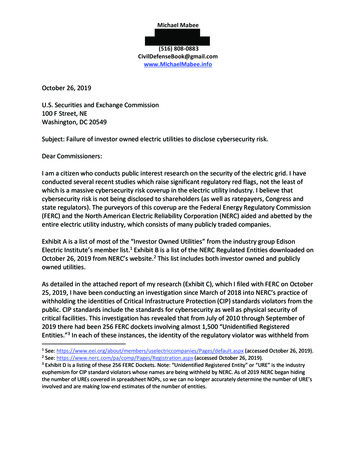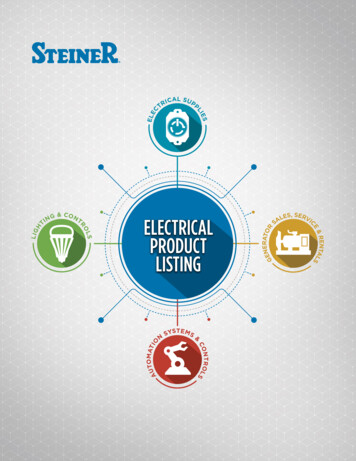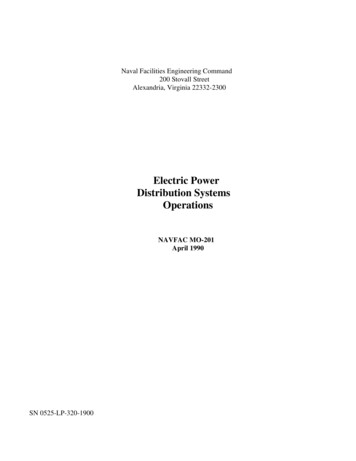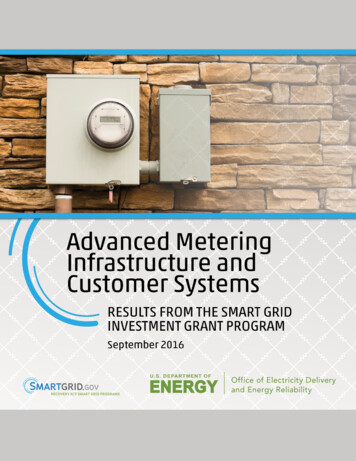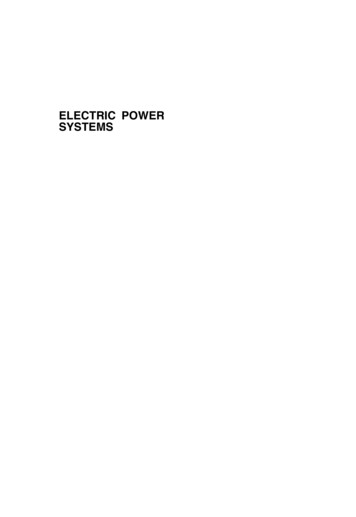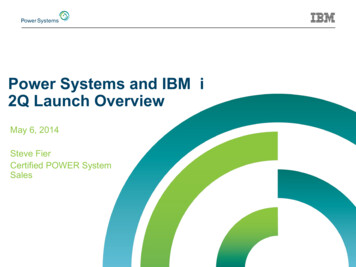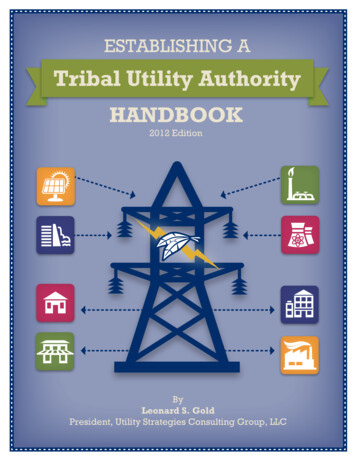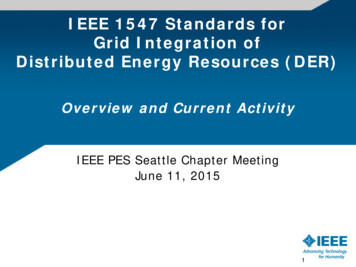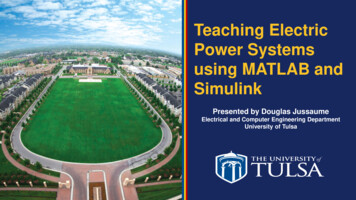
Transcription
Teaching ElectricPower Systemsusing MATLAB andSimulinkPresented by Douglas JussaumeElectrical and Computer Engineering DepartmentUniversity of Tulsa
AgendaMathWorks at the University of Tulsa ECE’s usage of MATLAB / SimulinkECE 3033 Electric Power Systems courseEngineering Labs Importance of Engineering LabsWhy the change to Virtual Power LabsECE 3033 Virtual Power Labs Implementation and Development TimelineVirtual Power Lab Design FeaturesVirtual Power Lab DemonstrationStudent FeedbackBenefits of a Virtual LabEvolving the Virtual Lab Concept Next Steps in Evolving the Virtual LabPower Lab RevisionsIntegrating Power Lab Models into the classroomThree-Phase Power System Demonstration using Live EditorSummary and Acknowledgements
University of Tulsa’s Electrical and Computer Engineering DepartmentClassroom and Lab Usage of MATLAB and SimulinkAcademicYearCourse NumberCourse TitleECE 2003Electric Circuit AnalysisECE 2161Digital LabECE 3113Signals and Linear SystemsECE 4043Electronics IISophomoreJuniorGraduateSolve system of equations and perform complex algebra - Dr.Surendra SinghProgramming Arduinos with Digital Functions and basicHardware-in-the-Loop Simulation - Dr. Nathan HutchinsFourier series approximation, filtering - Dr. Heng-Ming TaiSimulate electronic circuits - Dr. Peter LoPrestiECE 4041Electronics LabControl SystemsPerformance evaluation of PID control, design by root-locus andBode techniques - Dr. Heng-Ming TaiECE 4073Communication SystemsSpectrum representation and modulation simulation - Dr. HengMing TaiECE 4353/6723 /CS 4753Robotics IECE 5353/7353Aircraft Systems, Simulation,and ControlEE 7023Advanced ElectromagneticsECE 4053SeniorUseModeling dynamics, control system design, visualization, andsolving simultaneous equations - Dr. Loyd HookDevelop Method of Moments code for scattering from cylinders Dr. Surendra Singh
ECE 3033 Electric Power Systems Course Work and Hardware LabsCourse Faculty: Professor Douglas JussaumeJunior Level course Lecture on Magnetic Circuits/Three-Phase Systems / Transformers / DC & AC Motors andGeneratorsNo independent lab course – labs integrated into the course workIntegrated Labs Lab Introduction with a single-phase transformer and complex loadThree-Phase System - DC Motor - AC Synchronous GeneratorLab Set-up Single lab benchtopModular hardware - Motor/Generators, Transformers, Transmission Line, Complex loadsMeasure Voltage, Current, Frequency, Torque, and SpeedReal time display of complex power, power factor, voltage/current, torque/speed, and frequency
AgendaMathWorks at the University of Tulsa ECE’s usage of MATLAB / SimulinkECE 3033 Electric Power Systems courseEngineering Labs Importance of Engineering LabsWhy the change to Virtual Power LabsECE 3033 Virtual Power Labs Implementation and Development TimelineVirtual Power Lab Design FeaturesVirtual Power Lab DemonstrationStudent Feedback Benefits of a Virtual LabEvolving the Virtual Lab Concept Next Steps in Evolving the Virtual LabPower Lab RevisionsIntegrating Power Lab Models into the classroomThree-Phase Power System Demonstration using Live EditorSummary and Acknowledgements
Importance of Engineering LabsSupport students in gaining experience and insight Build and Troubleshoot electrical circuits and systemsOperate complex circuits and systems through system measurements over range of inputsand system changesRelate classroom equivalent circuits to hardware performanceSupport student’s development of professional habits Perform lab operating as a lab team – collaborate–teamwork–work toward a common goalMost important – Communication – Learn to write a professional engineering lab reportSupport the university’s mission Improve student retention and interestIncrease the quality of our graduates
Why the Change to Virtual Power Labs?University COVID Restrictions Physical distanceCleaning equipment and lab surfacesLab Restrictions Single bench area – very confinedSingle set of equipment / hardwareResult Logistical nightmare in attempting to perform labs in a team settingSolution Develop virtual labsPersonnel Experience with MATLAB/Simulink NONE
AgendaMathWorks at the University of Tulsa ECE’s usage of MATLAB / SimulinkECE 3033 Electric Power Systems courseEngineering Labs Importance of Engineering LabsWhy the change to Virtual Power LabsECE 3033 Virtual Power Labs Implementation and Development TimelineVirtual Power Lab Design FeaturesVirtual Power Lab DemonstrationStudent FeedbackBenefits of a Virtual LabEvolving the Virtual Lab Concept Next Steps in Evolving the Virtual LabPower Lab RevisionsIntegrating Power Lab Models into the classroomThree-Phase Power System Demonstration using Live EditorSummary and Acknowledgements
Virtual Power Lab Implementation and Development TimelineMay2020SelectedMathWorksSimulink todevelop VirtualPower LabsEarly June2020Met with MathWorks- download freeMATLAB/SimulinkJune2020Started learningSimulink anddeveloping initialmodels usingSimscapeElectricalJuly2020 –Aug2020Continued labdevelopmentusing SpecializePower SystemsSept – Nov2020Junior classperform the virtualPower labsJan2021Independentstudy withgraduate andSenior students tocontinue PowerLabsdevelopment
Virtual Power Labs Design FeaturesControl Panel Hand-input changes in the lab’s parametersDisplay performance output for each change in inputPerform Open and Short Circuit Tests Determine equivalent circuit parametersVerify model performance using Power course’s equivalent circuit modelsEncourage the engineering student to “play” with the lab model Develop “feel” for the hardware and system performanceGuiding Design Philosophy: Mimic the Hardware Lab Experience “Mimic” meaning that the electrical engineering student must set-up the test conditions andthen record performance data by hand. No single button to push to collect, record, download, and display the data
ECE 3033 Virtual Power Lab Technical DetailsThree-Phase Power System Y-connected balanced Source and Load / 3-wire transmission line / Parallel RLC load impedanceMeasure the phase/line voltages, line current, real and reactive powers, and the power factor angleSingle Phase Transformer Step-up transformer with nonideal core / Parallel RLC loadMeasures the voltage and current on the source and load sides.DC Shunt Motor 10 HP / 1750 RPMDC Terminal Voltage: adjustable DC voltage, 0 – 300 V DCApplied Mechanical Load Torque: adjustable load torque, 0 – 200 N-mSynchronous Generator Synchronous Generator: 10.2 KVA, 460 V rms, 60 Hz, 1800 RPM, round rotor, Y-connectedParallel RLC load with adjustable circuit element valuesAdjustable generator speed, 0-3600 RPM, and field voltage, 0 – 150 V DC
ECE 3033 Virtual Lab Control Panel Technical DetailsThree-Phase Power System Control Panel: On/off individual load circuit elements, adjust their values, and adjust thetransmission line lengthSingle Phase Transformer Control Panel: On/off the individual load circuit elements and to perform open and shortcircuit testsDC Shunt Motor Control Panel: adjusts the terminal voltage and applied mechanical torque, displays load,armature and field currents, load and induced torques, terminal voltage, powers, andelectrical lossesSynchronous Generator Control Panel: adjust the generator speed and field voltage, displays the generator speed,induce torque, output real and reactive powers, power factor angle, and electric frequency
Simulink / Simscape: Three-Phase Power System Lab Demonstration
Student Feedback – Comparing Virtual Lab to Hardware LabHow did you feel about using virtual labs with Simulink? Did you have apreference compared to hardware?The student feedback was: I really hate labs because I find them very tedious, but I think doing them in Simulink madethem a lot more tolerable -- it (the virtual labs) was slightly less tedious I liked using the virtual labs. I feel it was equally helpful in learning the material as usinghardware. I think using hardware is more enjoyable at times because it feels more hands-on,however, the simulated labs were less stressful. Hardware also allows fortroubleshooting opportunities, which was not available for simulated labs. The simulations were a great opportunity to test a wide range of values that wouldnormally be constricted in a lab setting. Simulations avoid safety risks and deviceconstraints. Hardware provides technical experience and produces visual results, while Simulationprovides an efficient way to observe large data sets and trends from a system. Overall, Ibelieve that using both hardware and simulation for a lab would be most beneficial.
Student Feedback: Virtual Lab BenefitsAre there any benefits that you can say you saw using a virtual lab over aphysical one?The student feedback was: The worst part of in person labs is setting up the circuits, but that’s something we needto be able to learn and do. But I think the Simulink/Virtual labs are a lot more beneficial for astudent’s understanding and learning a concept. In my opinion, virtual labs allowed us to see what would happen theoretically in reality;however, I am a proponent of physical labs, where one can easily interact and understand thematerial more comprehensively. So, I guess what I’m saying is I definitely prefer Simulink/Virtual labs for trying tounderstand the theory behind things, because I think they’re easier to collect and analyzedata. However, I also think that doing physical labs, in order to understand how to usethe hardware, is just as necessary. Simulink labs would be a very useful addition to any labclass, if added in the right way.
Benefit of Virtual LabsStudent Benefits Gave students a feel for theory/concepts via interactive controls to understand theirbehavior in real-timeLabs available 24/7 – better match to student scheduleImprove their comfort level and confidence by working with the virtual labUniversity Benefits Lower lab costs – no lab maintenance – no more equipment cost – no lab assistantEasier to stay current with technologyAllow for virtual locationsAddress changing student populations and demographics -- changing student backgroundexperience – available for a wider student audienceFuture Employer Benefits Experienced in the virtual engineering environment and model-based design
AgendaMathWorks at the University of Tulsa ECE’s usage of MATLAB / SimulinkECE 3033 Electric Power Systems courseEngineering Labs Importance of Engineering LabsWhy the change to Virtual Power LabsECE 3033 Virtual Power Labs Implementation and Development TimelineVirtual Power Lab Design FeaturesVirtual Power Lab DemonstrationStudent Feedback Benefits of a Virtual LabEvolving the Virtual Lab Concept Next Steps in Evolving the Virtual LabPower Lab RevisionsIntegrating Power Lab Models into the classroomThree-Phase Power System Demonstration using Live EditorSummary and Acknowledgements
Next Steps in Evolving the Virtual LabsNext Step - Now Revise labs to address the student feedback – more visual – build the circuit Develop more virtual power labs Three-phase transformerDC Series and Induction motorParalleling generatorsIntroduce versions of the models into the classroomNext Step - Future Expand virtual lab to other topics Power electronics / RF/microwave / CircuitsFuture – virtual reality?
Virtual Power Lab RevisionsUniversal Control / Display Panel Switches, sliders, and knobs to control the labDisplays for the performance dataInteractive scopeBuild the Circuit The student builds the circuit using the lab assignment schematic and the "Library Browser“Add Warnings “You let out the magic smoke”Real Time /Continuous Circuit performance is updated as changes are madeAllow the student to "watch" the circuit
Integrating Power Lab Models into the classroomClassroom lecture Introduces Theory/Concepts/EquationsWork problemsWork Problems using MATLAB/Simulink Use versions of lab models revised for the classroomFlipped classroom allows students to “run” problems Explore bounds of the problemsSummarize active results – this is invaluable – get engineering students to communicateGuiding Design Philosophy: Learn in an Interactive and Visual Way Interactive control of the problem’s parameters - Real time display of numbers and graphs
Three-Phase Power System Demonstration – Extending the use of MATLAB/Simulink
AgendaMathWorks at the University of Tulsa ECE’s usage of MATLAB / SimulinkECE 3033 Electric Power Systems courseEngineering Labs Importance of Engineering LabsWhy the change to Virtual Power LabsECE 3033 Virtual Power Labs Implementation and Development TimelineVirtual Power Lab Design FeaturesVirtual Power Lab DemonstrationStudent Feedback Benefits of a Virtual LabEvolving the Virtual Lab Concept Next Steps in Evolving the Virtual LabPower Lab RevisionsIntegrating Power Lab Models into the classroomThree-Phase Power System Demonstration using Live EditorSummary and Acknowledgements
SummaryStudents liked the virtual labs Reinforced what is taught in the classroomAvailable 24/7 which supports the student’s scheduleProvided insight to the classroom conceptsECE Department liked the virtual labs Meet university’s CONVID restrictions and the course requirementsNo lab equipment breakdownsNo lab assistant requiredBut did not provide the complete hardware lab experience Needs to evolve the labs to gain the hardware experienceVirtual labs are here to stay – virtual engineering environment is here tostay
AcknowledgementsBritney BaxterECE Senior StudentThomas ReidECE Graduate StudentNathan Hutchins, Ph.D.ECE Faculty Member
douglas-jussaume@utulsa.edu
Single Phase Transformer Step-up transformer with nonideal core / Parallel RLC load Measures the voltage and current on the source and load sides. DC Shunt Motor 10 HP / 1750 RPM DC Terminal Voltage: adjustable DC voltage, 0 –300 V DC Applied Mechanical Load Torque:

